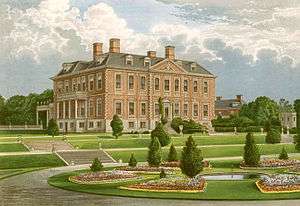Sir Jacob Astley, 1st Baronet
Sir Jacob Astley, 1st Baronet (ca. 1639 – 17 August 1729)[1] of Melton Constable Hall, Norfolk was an English Tory politician and baronet.

Background
He was the oldest son of Edward Astley and his wife Elizabeth Astley, daughter of his uncle Jacob Astley, 1st Baron Astley of Reading.[2] Astley was educated first at Norwich School,[3] then King's College, Cambridge,[4] and finally Christ Church, Oxford, where he matriculated on 19 June 1659.[5] On 7 September of the same year on the death of his paternal uncle Sir Isaac Astley, 1st Baronet, he inherited the estates of Hill Morton, Warwickshire and Melton Constable,[6] and in 1688 the Maidstone, Kent estates of his cousin Jacob Astley, 3rd Baron Astley of Reading.[6] In 1664 he commenced the building of the present Melton Constable Hall. He sold the Kent estate in 1720.
Career
Having been already knighted, Astley was created a Baronet, of Hill Morton, in the County of Warwick on 26 June 1660.[6] He was appointed High Sheriff of Norfolk for 1664 before entering the British House of Commons in 1685 as MP for Norfolk until 1689.[7] He represented the constituency again from 1690 to 1701, from 1702 to 1705 and a last time from 1710 to 1722.[7] Astley was High Sheriff of Norfolk in 1664 and Commissioner of Trade between 1714 and 1717.[8]
Family
On 6 February 1661, he married Blanche Wodehouse, eldest daughter of Sir Philip Wodehouse, 3rd Baronet.[9] They had four sons and a daughter.[2] Astley was buried at Melton Constable few days after his death.[9] He was succeeded in the baronetcy by his second and oldest surviving son Philip.[2] MP Philip Metcalfe was his great-grandson.
References
- "Leigh Rayment - Baronetage". Retrieved 1 May 2009.
- Debrett, John (1824). Debrett's Baronetage of England. vol. I (5th ed.). London: G. Woodfall. p. 219.
- Harries et al. (1991), p. 222
- "Astley, Jacob (ASTY657J)". A Cambridge Alumni Database. University of Cambridge.
- Eveline Cruickshanks, Stuart Handley and D. W. Hayton, ed. (2002). The House of Commons, 1690-1715. vol. III. Cambridge: Cambridge University Press. p. 83.
- Burke, John (1832). A Genealogical and Heraldic History of the Peerage and Baronetage of the British Empire. vol. I (4th ed.). London: Henry Colburn and Richard Bentley. p. 51.
- "Leigh Rayment - British House of Commons, Norfolk". Retrieved 1 May 2009.
- Haydn, Joseph (1851). The Book of Dignities: Containing Rolls of the Official Personages of the British Empire. London: Longman, Brown, Green and Longman's. pp. 178.
- "ThePeerage - Sir Jacob Astley, 1st Bt". Retrieved 30 December 2006.
- Bibliography
- Harries, R.; Cattermole, P.; Mackintosh, P. (1991). A History of Norwich School: King Edward VI's Grammar School at Norwich. Norwich: Friends of Norwich School. ISBN 978-0-9518561-1-6.
External links
- History of Parliament: Sir Jacob Astley
| Parliament of England | ||
|---|---|---|
| Preceded by Sir John Hobart Sir Peter Gleane |
Member of Parliament for Norfolk 1685–1689 With: Sir Thomas Hare, Bt |
Succeeded by Sir William Cook Sir Henry Hobart |
| Preceded by Sir William Cook Sir Henry Hobart |
Member of Parliament for Norfolk 1690–1701 With: Sir William Cook 1690–1695 Sir Henry Hobart 1695–1698 Sir William Cook 1698–1701 Roger Townshend 1701 |
Succeeded by Roger Townshend Sir John Holland |
| Preceded by Roger Townshend Sir John Holland |
Member of Parliament for Norfolk 1702–1705 With: Sir John Holland |
Succeeded by Roger Townshend Sir John Holland |
| Parliament of Great Britain | ||
| Preceded by Ashe Windham Sir John Holland |
Member of Parliament for Norfolk 1710–1722 With: Sir John Wodehouse 1710–1713 Sir Edmund Bacon 1713–1715 Thomas de Grey 1715–1722 |
Succeeded by Thomas de Grey Thomas Coke |
| Baronetage of England | ||
| New creation | Baronet (of Hill Morton) 1660–1729 |
Succeeded by Philip Astley |